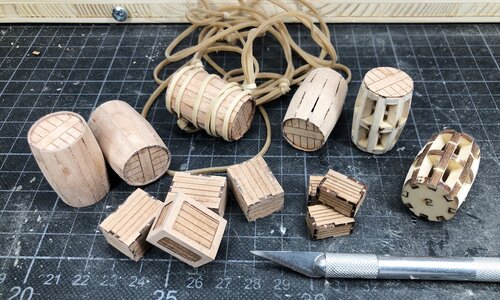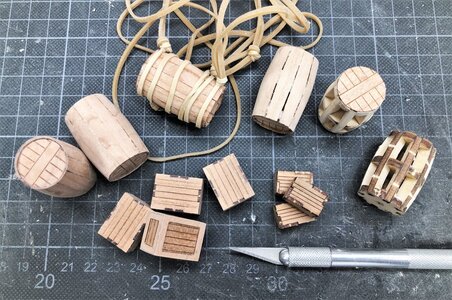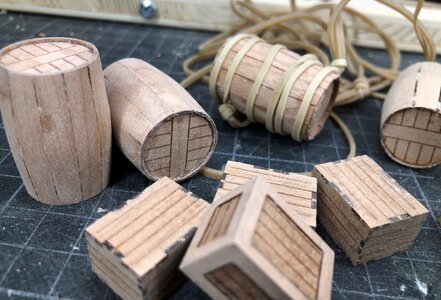Hallo friends,
first of all many thanks for the interesting comments and given information. This is very helpful.
During the weekend I worked mainly on the nailing, better bolting of the outside hull planking.
As mentioned earlier I am making the planking now with copper nails, a product from aeronaut, which are selling these nails in bags of 50 gramm, which means appr. 1.850 nails per bag. So one bag could be enough for the entire hull planking. For the wales I will use one ore two sizes bigger ones.
The marking of the bolt locations I described already earlier in this topic.
I am usually pre-drilling holes for the nails one size smaller, so here I am drilling holes with diameter 0,5mm.
Do you know the film "Kill Bill"? - you can call me now "Kill Drill" !!!
With a Proxxon drill it is not possible for me to drill several holes with this small drill without braking the drill. So therefore, in order to reduce the drill consumption to a tolerable quantity I am drilling the holes by hand.....every single hole - and this also very carfully not to break........
Here you see one frame exais marked with pencile,
the one above the holes are marked with a small dott with a fine scriber, so that the drill has a good lead
and the one above the row with predrilled holes and 5 nails insattled (using tweezers and a very small jeweler hammer)
View attachment 215377
all nails hammered (very gentle) of one row
View attachment 215378
cutting with side cutter - ready for sanding (this I do once more with my Pfeil set of files also shown in the past)
View attachment 215379
-

Win a Free Custom Engraved Brass Coin!!!
As a way to introduce our brass coins to the community, we will raffle off a free coin during the month of August. Follow link ABOVE for instructions for entering.
-

PRE-ORDER SHIPS IN SCALE TODAY!
The beloved Ships in Scale Magazine is back and charting a new course for 2026!
Discover new skills, new techniques, and new inspirations in every issue.
NOTE THAT OUR FIRST ISSUE WILL BE JAN/FEB 2026
- Home
- Forums
- Ships of Scale Group Builds and Projects
- Le Coureur 1776 1:48 PoF Group Build
- Le Coureur 1776 1:48 Group Build Logs
You are using an out of date browser. It may not display this or other websites correctly.
You should upgrade or use an alternative browser.
You should upgrade or use an alternative browser.
LE COUREUR - french Lugger 1776 - POF kit from CAF in 1:48 by Uwe
What is the size of the copper nails you used for the planks , for the courier, Uwek.could not find aeronaut reference you mentioned.
.
.
The used nails have 0,6mm diameter, the holes 0,5mmWhat is the size of the copper nails you used for the planks , for the courier, Uwek.could not find aeronaut reference you mentioned.
.
ah yeah i was wonering on the lenght
the length is not important, when you do it like myself..... mine where 8mm longah yeah i was wonering on the lenght
For a small brake and because of limted free time during the weekend I started to work on the barrels and the boxes.
To be honest I do not know, if I will pimp the boxes like @PoulD did in his log
due to the fact, that they will be stored in the hold and hardly to see, maybe only to upper one.......
In order to understand the way of construction, please take a look at the manual, which is explaing the way with several sketches
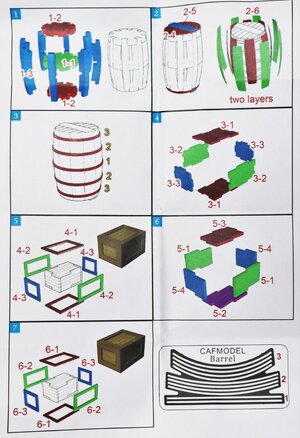
On this photo you can see the different working steps of the barrels.
The left barrel is covered with the first layer of staves
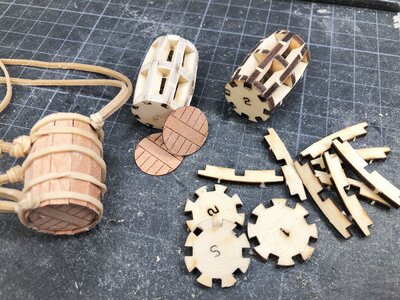
now the second layer is fixed - this evening, when the glue has dried and the sanding is done, I will see the result
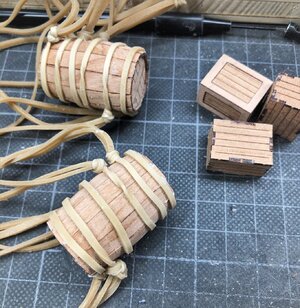
To be honest I do not know, if I will pimp the boxes like @PoulD did in his log
Le Coureur 1776, CAF model 1:48 by Poul
I'm still waiting for the HMS Alert 1776 kit which I wanted to make my very first build. For now I do not want to build 2 kits simultaneously so it will most likely take a long time before I start on Le Coureur. However, I have been waiting since May and since I received Le Coreur kit from CAF I...
shipsofscale.com
In order to understand the way of construction, please take a look at the manual, which is explaing the way with several sketches

On this photo you can see the different working steps of the barrels.
The left barrel is covered with the first layer of staves

now the second layer is fixed - this evening, when the glue has dried and the sanding is done, I will see the result

Today I can show the result of the barrel - the left one is sanded and cleaned
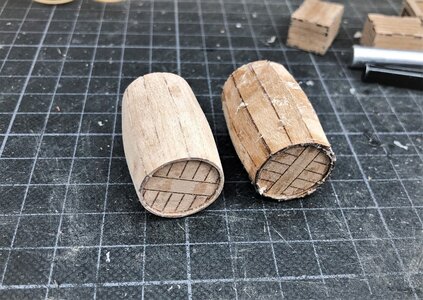
They are looking not so bad I think....
What I realized and I will make the other in this way:
It got a better result to use for the first layer only 11 staves, and not the planned 12 - with this you get some small gaps between, but they lay more smooth around the inner structure. The second layer is done with the planned 12. This is my subjective feeling

They are looking not so bad I think....
What I realized and I will make the other in this way:
It got a better result to use for the first layer only 11 staves, and not the planned 12 - with this you get some small gaps between, but they lay more smooth around the inner structure. The second layer is done with the planned 12. This is my subjective feeling
Gluing it is not so bad. The really complicated task is to get the skeleton (inside building jig) out when all the planks are glued.Ahoy!
It is a very complicated method of gluing wooden barrels
I'll show myself out
Kurt Konrath
Kurt Konrath
Great work on the water or rum barrels, I heard many old sailing ships carried rum because it stayed safer to drink then a barrel of water that got rancid quickly at sea. That and it made the crew feel better as the voyage went along for weeks.
- Joined
- Sep 28, 2020
- Messages
- 285
- Points
- 168

Keeping water fresh was a constant challenge.
Alcoholic beverages had a better life span.
When you read through the daily ration lists, the sailors must have been constantly under the influence of alcohol. And then climbing up the shrouds......
But maybe the daily routine and the living conditions on the ships could only be endured under the influence of alcohol.
Alcoholic beverages had a better life span.
When you read through the daily ration lists, the sailors must have been constantly under the influence of alcohol. And then climbing up the shrouds......
But maybe the daily routine and the living conditions on the ships could only be endured under the influence of alcohol.
Black Tot Day (31 July 1970)
was the last day on which the Royal Navy issued sailors with a daily rum ration (the daily tot).
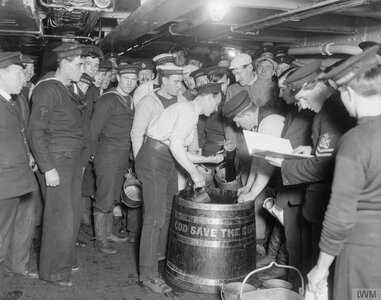
In the 17th century, the daily drink ration for English sailors was a gallon of beer (about four litres), although frequently small beer was used with an alcohol content below 1%. Due to the difficulty in storing the large quantities of liquid that this required, in 1655 a half pint (284 mL) of rum was made equivalent and became preferred to beer. Over time, drunkenness on board naval vessels increasingly became a problem and the ration was formalised in naval regulations by Admiral Edward Vernon in 1740 and ordered to be mixed with water in a 4:1 water to rum ratio and split into two servings per day.
In the 19th century, there was a change in the attitude towards alcohol due to continued discipline problems in the navy. In 1824 the size of the tot was halved to one-quarter of an imperial pint (142 ml) in an effort to improve the situation. In 1850, the Admiralty's Grog Committee, convened to look into the problems associated with the rum ration, recommended that it be eliminated completely. However, rather than ending it the navy further halved it to one-eighth of an imperial pint (71 ml) per day, eliminating the evening serving of the ration. This led to the ending of the ration for officers in 1881 and warrant officers in 1918.
On 17 December 1969 the Admiralty Board issued a written answer to a question from the MP for Woolwich East, Christopher Mayhew, saying "The Admiralty Board concludes that the rum issue is no longer compatible with the high standards of efficiency required now that the individual's tasks in ships are concerned with complex, and often delicate, machinery and systems on the correct functioning of which people's lives may depend". This led to a debate in the House of Commons on the evening of 28 January 1970, now referred to as the 'Great Rum Debate', started by James Wellbeloved, MP for Erith and Crayford, who believed that the ration should not be removed. The debate lasted an hour and 15 minutes and closed at 10:29 p.m. with a decision that the rum ration was no longer appropriate.
31 July 1970 was the final day of the rum ration and it was poured as usual at 6 bells in the forenoon watch (11am) after the pipe of 'up spirits'. Some sailors wore black armbands, tots were 'buried at sea' and in one navy training camp, HMS Collingwood, the Royal Naval Electrical College at Fareham in Hampshire, there was a mock funeral procession complete with black coffin and accompanying drummers and piper. The move was not popular with the ratings despite an extra can of beer being added to the daily rations in compensation.
Black Tot Day was subsequently followed in two other Commonwealth navies (the Royal Australian Navy having already discontinued the rum ration, in 1921):
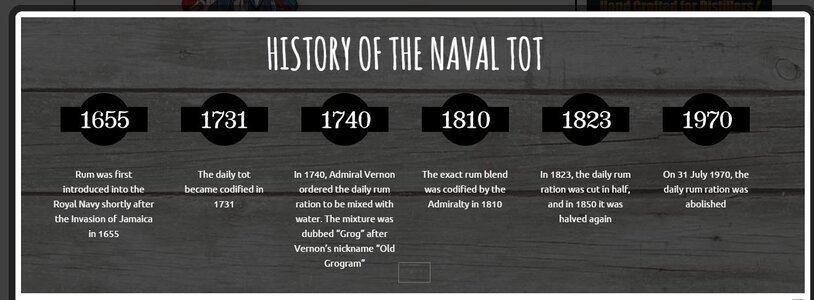

 en.wikipedia.org
en.wikipedia.org

 en.wikipedia.org
en.wikipedia.org
was the last day on which the Royal Navy issued sailors with a daily rum ration (the daily tot).

In the 17th century, the daily drink ration for English sailors was a gallon of beer (about four litres), although frequently small beer was used with an alcohol content below 1%. Due to the difficulty in storing the large quantities of liquid that this required, in 1655 a half pint (284 mL) of rum was made equivalent and became preferred to beer. Over time, drunkenness on board naval vessels increasingly became a problem and the ration was formalised in naval regulations by Admiral Edward Vernon in 1740 and ordered to be mixed with water in a 4:1 water to rum ratio and split into two servings per day.
In the 19th century, there was a change in the attitude towards alcohol due to continued discipline problems in the navy. In 1824 the size of the tot was halved to one-quarter of an imperial pint (142 ml) in an effort to improve the situation. In 1850, the Admiralty's Grog Committee, convened to look into the problems associated with the rum ration, recommended that it be eliminated completely. However, rather than ending it the navy further halved it to one-eighth of an imperial pint (71 ml) per day, eliminating the evening serving of the ration. This led to the ending of the ration for officers in 1881 and warrant officers in 1918.
On 17 December 1969 the Admiralty Board issued a written answer to a question from the MP for Woolwich East, Christopher Mayhew, saying "The Admiralty Board concludes that the rum issue is no longer compatible with the high standards of efficiency required now that the individual's tasks in ships are concerned with complex, and often delicate, machinery and systems on the correct functioning of which people's lives may depend". This led to a debate in the House of Commons on the evening of 28 January 1970, now referred to as the 'Great Rum Debate', started by James Wellbeloved, MP for Erith and Crayford, who believed that the ration should not be removed. The debate lasted an hour and 15 minutes and closed at 10:29 p.m. with a decision that the rum ration was no longer appropriate.
31 July 1970 was the final day of the rum ration and it was poured as usual at 6 bells in the forenoon watch (11am) after the pipe of 'up spirits'. Some sailors wore black armbands, tots were 'buried at sea' and in one navy training camp, HMS Collingwood, the Royal Naval Electrical College at Fareham in Hampshire, there was a mock funeral procession complete with black coffin and accompanying drummers and piper. The move was not popular with the ratings despite an extra can of beer being added to the daily rations in compensation.
Black Tot Day was subsequently followed in two other Commonwealth navies (the Royal Australian Navy having already discontinued the rum ration, in 1921):
- 31 March 1972 was the final day of the rum ration in the Royal Canadian Navy.
- 28 February 1990 was the final day of the rum ration in the Royal New Zealand Navy.


Rum ration - Wikipedia

Rum ration - Wikipedia
But also very interesting is this page
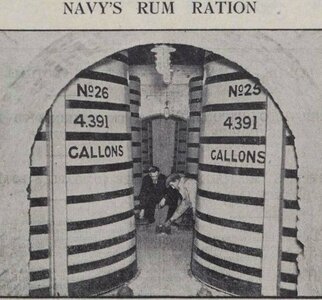
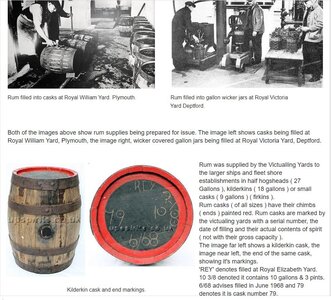
=> So the Royal Navy used for rum barrels with maximum 27 gallons (british) - which means appr. 120 liters
So our barrels of the Le Coureur, which are much bigger, are for transport of some other fluids, but not for rum -> SORRY
Otherwise we had also to mark the chimbs with red colour.......
So we learnt something new today
Supply of rum to the Royal Navy


=> So the Royal Navy used for rum barrels with maximum 27 gallons (british) - which means appr. 120 liters
So our barrels of the Le Coureur, which are much bigger, are for transport of some other fluids, but not for rum -> SORRY
Otherwise we had also to mark the chimbs with red colour.......
So we learnt something new today
- Joined
- Sep 28, 2020
- Messages
- 285
- Points
- 168

Unimaginable by today's standards, 0.0 everywhere.
If I remember correctly, Boudriot's "74 Gun Ship" also talks about a generous daily ration of wine. Very probably diluted.
If I remember correctly, Boudriot's "74 Gun Ship" also talks about a generous daily ration of wine. Very probably diluted.
- Joined
- Sep 28, 2020
- Messages
- 285
- Points
- 168

The barrels remind me of an Asterix volume (Britons?) in which the Romans search for the magic potion in hundreds of barrels of alcohol.But also very interesting is this page
Supply of rum to the Royal Navy
View attachment 221548
View attachment 221547
=> So the Royal Navy used for rum barrels with maximum 27 gallons (british) - which means appr. 120 liters
So our barrels of the Le Coureur, which are much bigger, are for transport of some other fluids, but not for rum -> SORRY
Otherwise we had also to mark the chimbs with red colour.......
So we learnt something new today
Very disciplined at first, but then.....
@Uwek, about the copper nails you got from aeronaut ...do you have the part number. have been lookink high and low for some.The used nails have 0,6mm diameter, the holes 0,5mm
Here we are - the "Kupferstifte dia 0,6 * 8mm, ca. 50g /appr. 1.800 pcs, Art.Nr 7790/52 by www.aero-naut.de@Uwek, about the copper nails you got from aeronaut ...do you have the part number. have been lookink high and low for some.
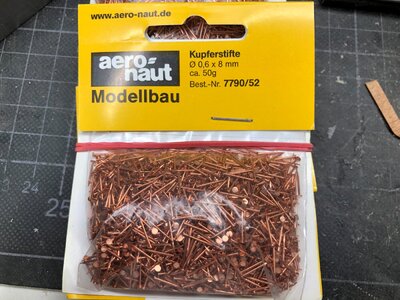
KUPFERSTIFT 0.6x 8 - aeronaut Modellbau
unfortunately in moment not available from aeronaut directly - as I know, these small nails are usually produced in Itlay and there seems to be problems in the production....
but I found them f.e. here (especially because of the article number):
Kupfernägel Flachkopf 0,6 x 8 mm (25 g) • Steingraeber-Modelle • der Spezialist für historischen Schiffsmodellbau
Kupfernägel Flachkopf 0,6 x 8 mm (25 g) ca. 25 g Kupfer-Nägel, mit Flachkopf, ca. 750 Stck. Eigenschaften: Kopfdurchmesser: ca. 2,5 mm Schaftdurchmesser: ca. 0,6 mm Schaftlänge: ca. 8 mm Material: Kupfer Verpackungsein...

ok I will give it a try...I wiil let you in on a new event... I have recieved a CAF courier. the plans have been copied, the monograf by ancre has arrived also. Soon I will start..been following the group build.Need to update my work on my other ship too, the bulworks are neally complete. and the gun ports cut out, will try to post pics this weekendHere we are - the "Kupferstifte dia 0,6 * 8mm, ca. 50g /appr. 1.800 pcs, Art.Nr 7790/52 by www.aero-naut.de
View attachment 221709
KUPFERSTIFT 0.6x 8 - aeronaut Modellbau
aero-naut.de
unfortunately in moment not available from aeronaut directly - as I know, these small nails are usually produced in Itlay and there seems to be problems in the production....
but I found them f.e. here (especially because of the article number):
and also hereKupfernägel Flachkopf 0,6 x 8 mm (25 g) • Steingraeber-Modelle • der Spezialist für historischen Schiffsmodellbau
Kupfernägel Flachkopf 0,6 x 8 mm (25 g) ca. 25 g Kupfer-Nägel, mit Flachkopf, ca. 750 Stck. Eigenschaften: Kopfdurchmesser: ca. 2,5 mm Schaftdurchmesser: ca. 0,6 mm Schaftlänge: ca. 8 mm Material: Kupfer Verpackungsein...www.steingraeber-modelle.de



